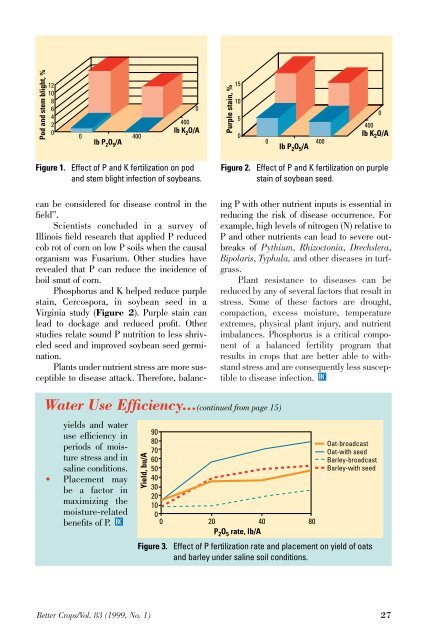Phosphorus Nutrition Improves Plant Disease Resistance
Phosphorus Nutrition Improves Plant Disease Resistance
Phosphorus Nutrition Improves Plant Disease Resistance
Create successful ePaper yourself
Turn your PDF publications into a flip-book with our unique Google optimized e-Paper software.
Pod and stem blight, %<br />
12<br />
10<br />
8<br />
6<br />
4<br />
2<br />
0<br />
0 400<br />
lb P 2<br />
O 5<br />
/A<br />
0<br />
400<br />
lb K 2 O/A<br />
Purple stain, %<br />
15<br />
10<br />
5<br />
0<br />
0 400<br />
lb P 2 O 5 /A<br />
0<br />
400<br />
lb K 2 O/A<br />
Figure 1. Effect of P and K fertilization on pod<br />
and stem blight infection of soybeans.<br />
Figure 2. Effect of P and K fertilization on purple<br />
stain of soybean seed.<br />
can be considered for disease control in the<br />
field”.<br />
Scientists concluded in a survey of<br />
Illinois field research that applied P reduced<br />
cob rot of corn on low P soils when the causal<br />
organism was Fusarium. Other studies have<br />
revealed that P can reduce the incidence of<br />
boil smut of corn.<br />
<strong>Phosphorus</strong> and K helped reduce purple<br />
stain, Cercospora, in soybean seed in a<br />
Virginia study (Figure 2). Purple stain can<br />
lead to dockage and reduced profit. Other<br />
studies relate sound P nutrition to less shriveled<br />
seed and improved soybean seed germination.<br />
<strong>Plant</strong>s under nutrient stress are more susceptible<br />
to disease attack. Therefore, balancing<br />
P with other nutrient inputs is essential in<br />
reducing the risk of disease occurrence. For<br />
example, high levels of nitrogen (N) relative to<br />
P and other nutrients can lead to severe outbreaks<br />
of Pythium, Rhizoctonia, Drechslera,<br />
Bipolaris, Typhula, and other diseases in turfgrass.<br />
<strong>Plant</strong> resistance to diseases can be<br />
reduced by any of several factors that result in<br />
stress. Some of these factors are drought,<br />
compaction, excess moisture, temperature<br />
extremes, physical plant injury, and nutrient<br />
imbalances. <strong>Phosphorus</strong> is a critical component<br />
of a balanced fertility program that<br />
results in crops that are better able to withstand<br />
stress and are consequently less susceptible<br />
to disease infection.<br />
Water Use Efficiency...(continued from page 15)<br />
yields and water<br />
use efficiency in<br />
periods of moisture<br />
stress and in<br />
saline conditions.<br />
• Placement may<br />
be a factor in<br />
maximizing the<br />
moisture-related<br />
benefits of P.<br />
Yield, bu/A<br />
90<br />
80<br />
70<br />
60<br />
50<br />
40<br />
30<br />
20<br />
10<br />
0<br />
0 20 40 80<br />
Oat-broadcast<br />
Oat-with seed<br />
Barley-broadcast<br />
Barley-with seed<br />
P 2 O 5 rate, lb/A<br />
Figure 3. Effect of P fertilization rate and placement on yield of oats<br />
and barley under saline soil conditions.<br />
Better Crops/Vol. 83 (1999, No. 1) 27
















